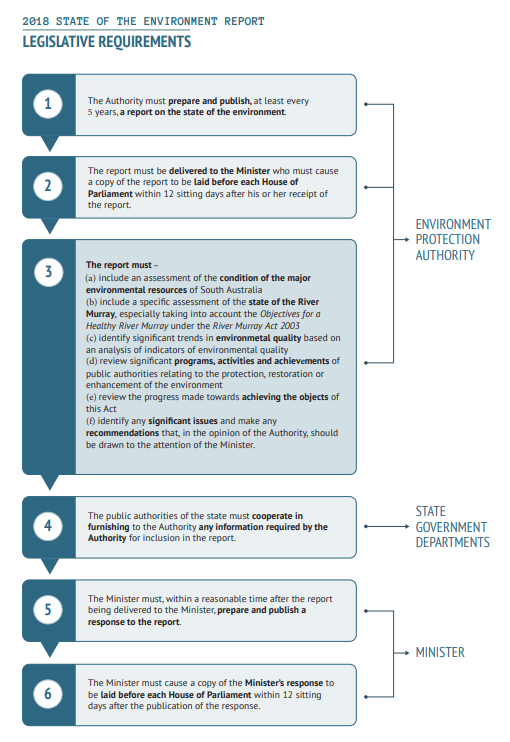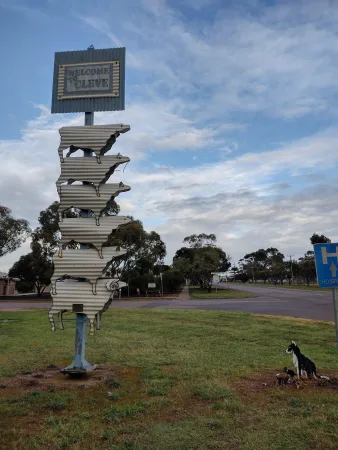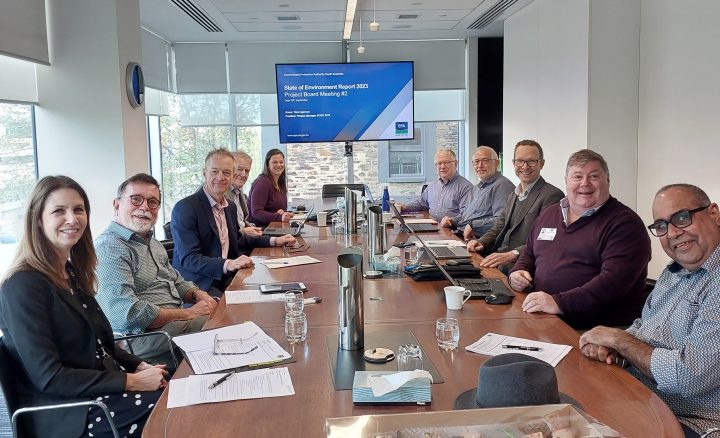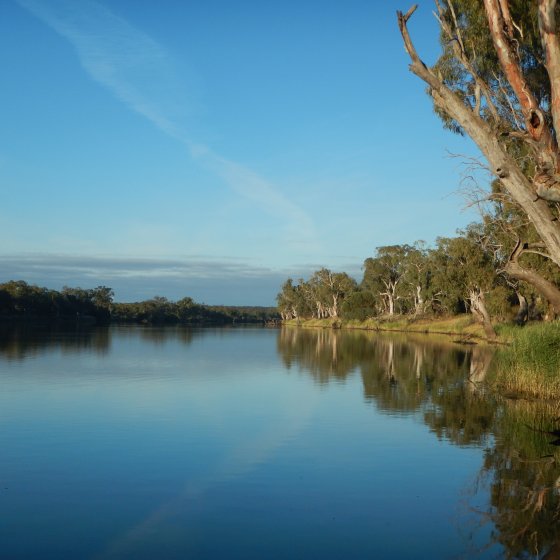Why Report
Legislative requirements for the preparation of the SOER is prescribed under section 112 of the Environment Protection Act 1993 (EP Act).

Purpose of Reporting
Good-quality, up-to-date information is needed to enable us to effectively manage and protect our environment. This includes the condition of our natural assets, trends in condition over time, causes of environmental change and the effectiveness of management responses to those changes.

New Concepts
Upon completion of the 2018 SOER, the EPA undertook an independent review to identify areas for improvement. In response to this review, the EPA sought to improve its stakeholder engagement by establishing a YourSAy page to seek input from the general community, undertook regional engagement and expanded stakeholder representation on the SOER Project Board and Assurance Group. An interagency project team was also formed and included staff from the Department for Environment and Water (DEW) who were responsible for preparing South Australia’s environmental trend and condition report cards 2023,
The 2018 State of the Environment Report for South Australia acknowledged that it did ‘not explicitly reflect the perspectives of Aboriginal people’, that the report ‘would be more complete with this perspective’ and that this ‘will be addressed in the next report’. For the first time, the 2023 SOER has included the views of Aboriginal peoples on ‘How Healthy is Country’.
The 2023 SOER will also incorporate regional content into the framework. This will provide a collation of environmental information that is more relevant to regional areas, based on Landscape SA boundaries. The DEW report cards also provide a regional assessment for some of their indicators.
General stakeholder feedback highlighted the importance of reporting on the implementation of SOER recommendations and the 2023 SOER reports on the South Australian Government and agency work that aligns with the recommendations made in the 2018 report.
Governence
The EPA Board is responsible for the delivery of the SOER to the Minister with the assistance of agency staff and key stakeholders. The development of the report was supported by a Project Board appointed by the Chief Executive of the EPA. The purpose of the Board was to provide strategic direction to inform the report’s content. This included the framework of the Summary Report and key recommendations and issues that have been presented to the Minister for Climate, Environment and Water. An interagency project team was also formed and included staff from the Department for Environment and Water (DEW) who were responsible for preparing South Australia’s environmental trend and condition report cards 2023, form an integral part of the SOER.
Membership of the 2023 SOER Project Board consisted of the following people:
NAME | ROLE |
|---|---|
| Mr Keith Baldry | Project Executive, EPA |
Ms Sandy Carruthers | Executive Director, Strategy, Science and Corporate Services, DEW |
| Dr Stephen Christley | EPA Board Member |
| Professor Chris Daniels | Chair, Green Adelaide; Adjunct Professor at UniSA and the University of Adelaide |
| Dr Jon Gorvett | Chair SOER 2023 Project Board (as Chief Executive EPA) |
| Ms Tara Ingerson | Project Manager SOER 2023, EPA |
| Mr Rob Kerin | Chair, Regional Development Australia (South Australia) |
| Mr Ian Liddy | Project Officer, Aboriginal Affairs and Reconciliation, Attorney-General's Department |
| Mr Andrew Solomon | Project Officer, SOER 2023, EPA |
| Mr Craig Wilkins | Chief Executive, Conservation Council SA |

Future Reporting
Environmental reporting is undertaken by a number of South Australian Government agencies, including DEW, Landscape Boards and the EPA. In addition, State of the Environment Reporting is also undertaken at a national level, which includes state-based information.
A continuing issue that has been raised by recommendations in previous SOERs has been the lack of data and information for some environmental aspects and the limited reliability of current data in other cases. In addition, the need for better integration of environmental reporting and the consistent collection of data across government has also been raised. DEW’s expansion of its trend and condition reporting has been a response to this challenge, and it is implementing further measures to address this. However, this is still a significant issue for South Australia, making it difficult to prioritise where environmental investments are to be targeted and assess the effectiveness of programs aimed at protecting and restoring environmental condition. It is recognised that further improvements in environmental reporting need to be made to better incorporate the views of Aboriginal peoples, further integrate with reporting undertaken by DEW and Landscape Boards, and align with national reporting frameworks.
There is also some uncertainty regarding the desired targets for the condition of the state’s environmental assets, that is, what we are measuring against and what the desired environmental condition is that we are seeking to achieve. It would be preferable to identify what success looks like and continually evaluate the effectiveness of policies and programs to ensure they are meeting the desired aims. This will help inform future statewide and regional priorities, and strategic planning.
A National Strategy and Action Plan was released by the Australian Government in 2018 to develop a common national approach for environmental reporting, which adopted environmental economic accounting. This principle was agreed to by all environment ministers across Australia in 2017. The Plan recognises many benefits that a consolidated approach to environmental reporting would bring to support environmental decision-making.
Therefore, environmental reporting for South Australia needs to be reviewed to improve and refine information that measures progress in responding to key environmental issues and to link indicators to the health and wellbeing of the community and the environment. Potential options for improvement may include:
- Providing a road map that outlines future reporting processes to monitor and report on South Australia’s natural assets.
- Broadening the context for environmental reporting that incorporates indicators that link the environment to health, wellbeing and liveability in Greater Adelaide and regionally. This may include adopting other reporting frameworks such as natural capital accounting, including Environmental Economic Accounting, data visualisation tools and interactive reporting, and provision of real-time data. This will help inform the assessment of impacts and benefits from policy responses and support South Australia in keeping pace with national harmonisation of environmental accounting and reporting. Other frameworks that may be considered include reporting against ecosystem services, planetary boundaries and/or sustainable development goals that would help inform the selection of indicators and triggers for action.
- A statewide approach for monitoring to ensure consistency in collecting data that can be used for reporting on environmental condition at different time and spatial scales.
- Ensuring that indicators and data collection identify whether government programs are achieving the desired environmental outcomes.
- Improving capacity to collect/collate reliable and consistent data from various sources to assess and report on environmental trend and condition. This will help better inform state and federal government decisions for environmental protection and restoration at the landscape, regional or state scale.
- Aligning with national and international monitoring and reporting frameworks to enable consolidation and comparison of environmental data and the condition and trend of our environmental assets.
- Building meaningful relationships with Aboriginal peoples to incorporate their values, knowledge and expertise regarding trend and condition of the environment and associated responses.
- Ensuring that recommendations identified in the SOER are followed by actions for implementation, with clear roles and timeframes for delivering these recommendations.
- Reviewing reporting requirements in relevant legislation to ensure they are fit for purpose and have a clear role in the protection and restoration of our environment.
